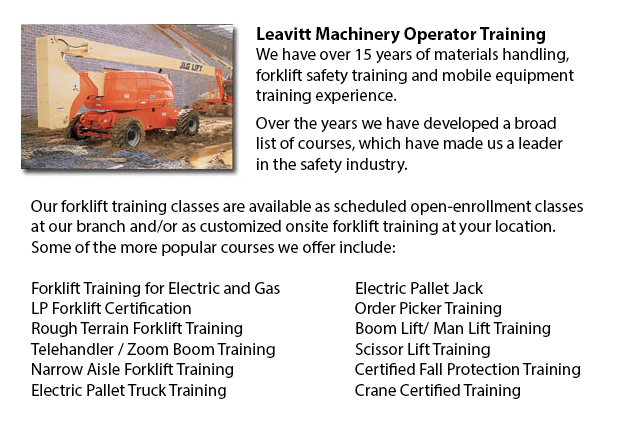
Cambridge Manlift Training - There are many manlift training courses which offer a review of the manlift equipment. The practicum part of the training is another vital portion of the program. In this section the trainee has chance to demonstrate their practical abilities, their ability to safely operate a manlift. A prerequisite to Manlift training is the fall protection training, which could be incorporated in the training based on the particular needs of the customer.
Course Content
The course content consists of: the effect of performing unsafe acts or utilizing unsafe machinery, pre-shift equipment check and work area survey requirements, Lifting device equipment definitions, Review of load capabilities, safety decals and particular equipment requirements, Review of related sections of the OSHA Standards and the CSA Standards and Review site particular Hazards, together with controls for safe use of a lifting device.
Demonstration and Evaluation Content
The demonstration and evaluation part of the program includes: Proper personal protective equipment or also known as P.P.E. as required; Making use of a signaler or a spotter when needed; Using a correct fitting harness or fall arrest devise; Utilizing a lift only on solid and level ground; Using the lift with all other staff clear of the job site; Aware of load limits etc. and other specs as set out by the manufacturer; Having all associated machinery stored safely on the lift platform; Pre-shift work area survey and machine inspection; Ensuring a smooth and safe operating speed for various plant conditions and isolating off the work area when major work projects are to be finished.
Each of the trainees would undergo testing to make certain that they can safely operate their machine.
Manlift Safety
Because the manlift is capable of lifting personnel and materials over 20 feet in the air, these equipment pose a particular amount of risk and can be dangerous equipment if not used correctly. Since the danger is so apparent, lift operators and owners are careful to correctly maintain their machines and follow proper operating procedures and safety precautions. The ratio of accidents involving this specific machinery is fairly low.
The safety specifications for scissor lifts and boom lifts puts the burden for safe manlift operation on the user. You are responsible for understanding how to safely operate the lift even if you only rent the machine for one day. The most basic safety features on the machinery are safety decals and the operating guidebook. These show essential information about the operating procedures, safety equipment and maintenance.
A new model of manlift will come along with the necessary decals in place and operating manuals. The operating manual must be found on the machinery at all times. If you are buying a used lift, it is vital to make certain that the guidebook is included and that vital decals haven't been painted over. The restraints which prevent operators from falling and the guardrails are other essential safety features. These are mandatory and standard on all types of lifts.
-
Cambridge Aerial Boom Lift Ticket
Cambridge Aerial Boom Lift Ticket - Aerial lifts can accommodate many tasks involving high and hard reaching places. Often used to perform routine upkeep in structures with elevated ceilings, prune tree branches, raise burdensome shelving units or me... More -
Cambridge Heavy Equipment Training
Cambridge Heavy Equipment Training - The two most common types of heavy equipment training are classed into the categories of machines; equipment that is fashioned with tracks and those with rubber tires. The tracked vehicle are heavy duty equipment... More -
Crane / Overhead Crane / Self-Erect Crane / Truck Mounted Crane / Hydraulic Cranes Training in Cambridge
Overhead cranes are likewise referred to as bridge cranes. They are a type of crane that has a hook and line mechanism which runs along a horizontal beam which runs along two widely separated rails. Several overhead cranes could be found in a long fa... More -
Cambridge Warehouse Forklift Training Classes
Cambridge Warehouse Forklift Training Classes - The reason for warehouse training classes are to raise the awareness of common workplace hazards. Those training would learn necessary warehouse safety procedures. An emphasis is placed on paying attent... More -
Cambridge Heavy Equipment Training School
Cambridge Heavy Equipment Training School - The heavy equipment operator courses would assist the operator in attaining the needed skills and knowledge they would need to be able to enter the workforce as an entry level operator. In this 12 week cour... More -
Cambridge Telehandler Training
Cambridge Telehandler Training - Telehandlers or also called Telescopic handlers are really popular piece of heavy construction machinery most often utilized in construction and agricultural industries. These machines have maximum reaching ability an... More -
Cambridge Boom Lift License
Cambridge Boom Lift License - To operate an aerial boom lift, operators should be certified through training which can be attained utilizing both practical training and classroom sessions and by attaining a boom lift license. Instruction must be give... More -
Cambridge Wheel Loader Training
Cambridge Wheel Loader Training - Normally, the various kinds of heavy equipment training are divided into 2 categories of equipment: those which have rubber tires and tracked vehicles. Tracked vehicles consist of items such as excavators, cranes, an... More

Forklift Certification Cambridge
TOLL FREE: 1-888-254-6157
Cambridge, Ontario
forkliftcertificationcambridge.com
Email Us
About Us


